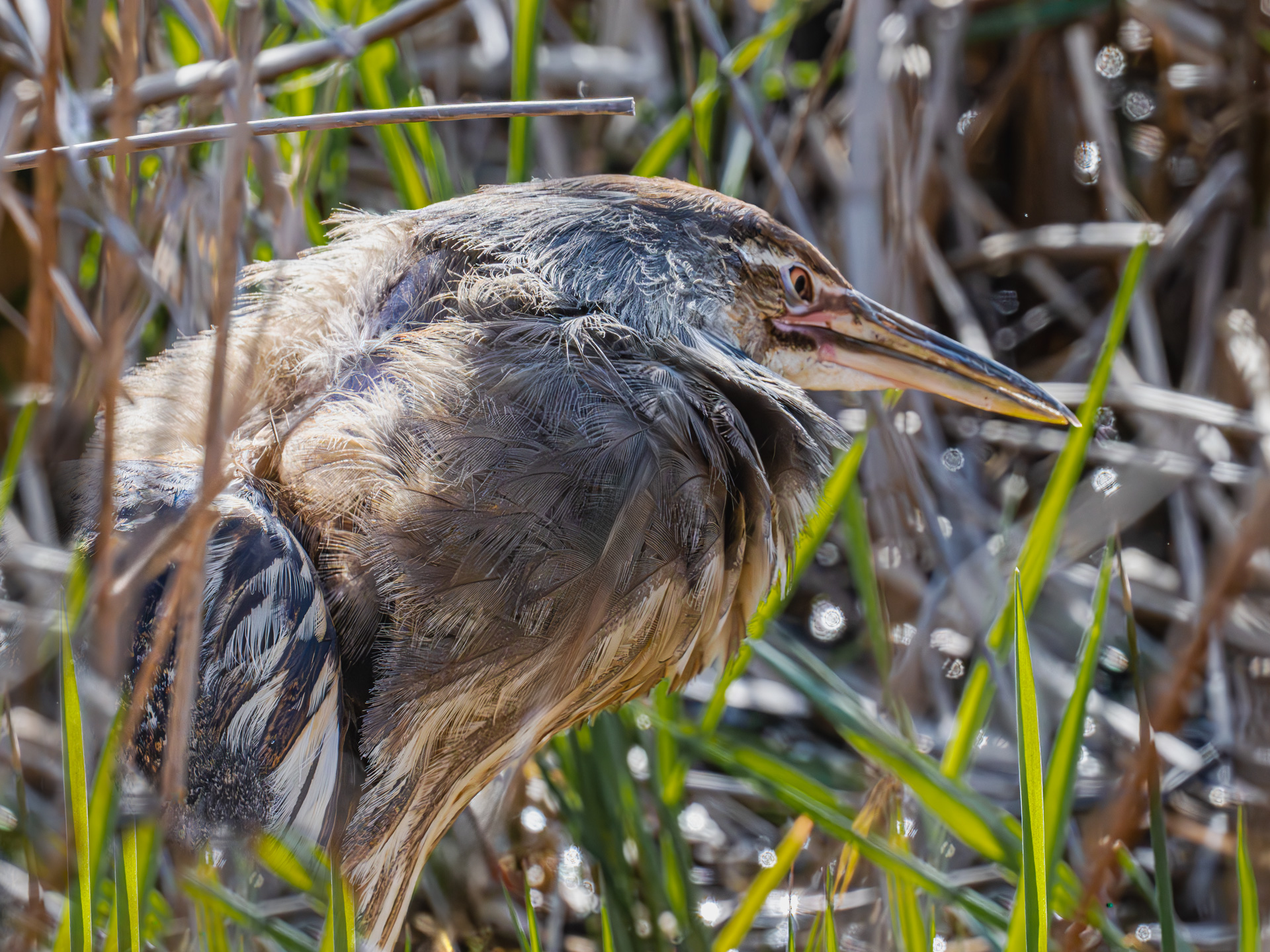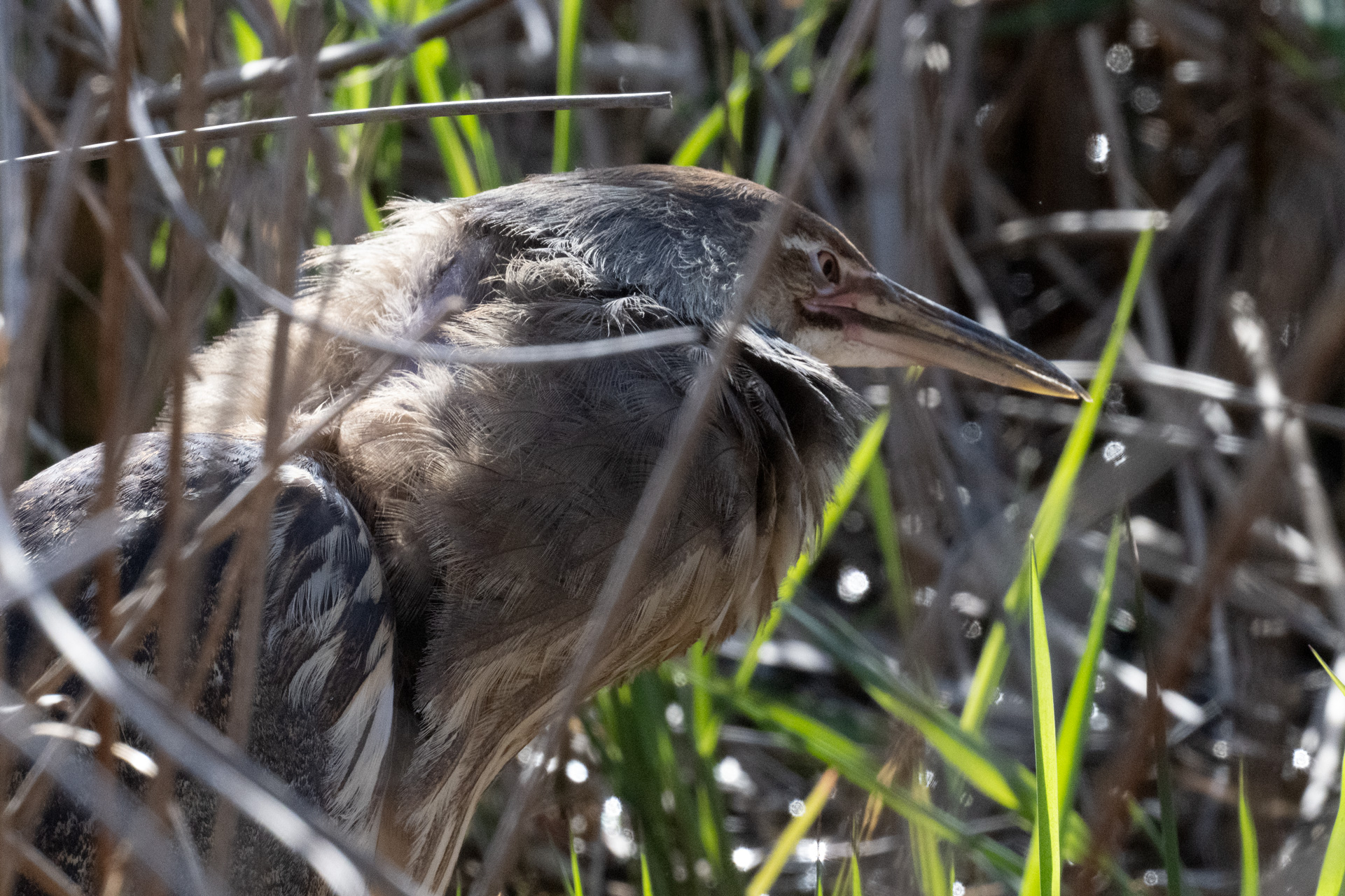Susan Cifaldi
About the Image(s)
GEAR: This was a real lesson for me. First I used the d500, as I was feeling a bit guilty about abandoning my Nikon DSLRs (which are reallyreallyREALLY good cameras). So, at first it was d500 with the 300mm prime. I put the camera in Automatic mode and then replicated/tweaked the suggested settings. . .and the result was AWFUL. Glare was everywhere and nothing was in focus. I ended up deleting everything on the card. Then I tried the Z9 with the 500mm PF lens and 1.4 converter. I used the EVF to determine what looked decent, which was ended up being 1250, f/16, no compensation, and ISO 5000. The result was not perfect but was much better. All in all, I thought the lighting was rather challenging, at least for me -- even though it was 4:30 PM the light was still harsh but blocked only a little by the dark surroundings.
Anyway.
I realize it's kinda soft. I had difficulty keeping the camera from re-focusing on nearer reeds, but all things considered I think it's decent. I did a lot of editing, which I am not very good at, but cropping, increasing exposure, de-noising, sliding up the contrast, and brightening definitely immproved things. I did remove a few of the reeds and rushes that concealed this guy, but I wanted to leave enough of its environment to reveal why bitterns are really hard to find and aren't easy to photograph. I also played with the clone stamp to fill in a weeded area that looked a bit blank.
They are silly things with the craziest mating call I have ever heard. In fact, that's how I found it -- it was calling and calling and wouldn't stop. It was kinda cool to watch it expand its chest, kinda gulp, and then emit a call that sounds like a slow-draining kitchen sink (don't ask me how I know).
In western NY, the American bittern is listed as "special concern," even though the surrounding states consider it an endangered species due to loss of habitat. The marsh where I found this bird is (IMHO) poorly run by managers who know all about habitat loss. Right now they are actively draining the wetlands under their control, which has become an annual ritual that skews the environment toward the special needs of fall-migration ducks (and duck hunters). So, nature-viewing season will be completed here within the next week or two, as the marshes become mudflats and the food web is dried up. Sigh.
I need to travel!!!! Thinking of going to Magee Marsh in a couple of weeks.
I welcome your criticism and comments. Thanks!!!
7 comments posted
As I explained, I struggled a lot with this image. The two extremes of light, the furtive subject, and my own inexperience all combined to give me a headache, which continued once I started processing. Since Photoshop doesn't get along with my computer, I've been fooling around with alternatives, including Affinity and DxoPhotoLab 8. This image is the DxO result. Their denoising feature is awesome -- there are 4 options (5 if you have a Fuji with the X-Trans sensor) and no sliders to fool around with, and switching from one to another is instantaneous. But their remove/repair tool (they call it re-touch) is hideous. Rather than removing the interference as a layer to reveal what should be underneath (like PS does), their version acts more like a clone stamp, where it samples a similar area to replace the re-touched area. The results are unreliable -- but to be fair I may not have been using the feature correctly. Anyway, after fooling around with it for far too long with the result looking like someone had sneezed on it, I ended up going back into PS and using their remove tool.
Now for my second issue, which I didn't know was an issue until you brought it up. :-) I took many photos using different angles and settings. I do have some 90* images, where the heron is looking straight ahead and parallel to me, but I chose this one because (forgive me!) I liked it. I thought it was more interesting because s/he isn't staring straight ahead but seems to be surveying what is lying just out of camera range while enjoying the protection of the natural environment. I wanted to maintain that sense of a protection so I used the removal tool judiciously (and even cloned a couple of weeds into some of the blanker areas). Nor did I want to disturb the contrast between the dark surrounds and the little glimmers of (harsh) light that poked through, an attractive (to me) contrast that revealed the watery marsh that the bird was standing in.
I guess this brings me to a dilemma that has haunted me since day one -- what is a "good" photo? Is it one that follows the rules of competition (which I clearly know nothing about) or is it "good" if the technology manages to capture both physical characteristics and emotional appeal? Korczak Ziolkowski, the sculptor who died before completing his magnum opus, the Crazy Horse Memorial, was not classically trained nor was he a photographer, but when asked about sculpting as an art, he would say "I may not know much about art, but I know what I like" which I've adopted as a sort of mantra. But am I correct in doing so? Is that holding me back from improving (I'm really tired of being a newbie!). Can the two philosophies coexist, or are they mutually exclusive?
I apologize if this is out of line and I mean no disrespect, but if you have the time and inclination I'd like to know your thoughts. If not, then let's continue upward and onward. :-) Posted: 05/07/2025 16:31:30
As for Photoshop-bah! who cares! I do 99% of my editing in Lightroom and with the latest upgrade I may never open Photoshop again. he new masking tools are awesome. And if you are going to use denoise do it right after you adjust the lens corrections. The new Lightroom has an excellent remove tool, actually three of them.
I'm going to answer your next two parts together, because they really are the same thing. We are going to talk nature images mainly but most of this applies to any picture. What makes a great picture will forever be up for debate but there are basics that make a good set of guidelines. So what is first---Getting it right technically which is mainly two things--nail the exposure, no excuses. Second, get it sharp. Fail there, then put it in the trash can.
Next are the five basics and for nature I'll add a sixth.
1. Be original. Take something no one else is going to duplicate. Don't shoot an osprey in flight (boring) get him in the stoop! Wings folded, talons out. Sharp and properly exposed you have a winner! Period
2. Have a strong subject. One that is clear, easily understood, COMPELLING (One that is emotional, one that generates that OMG! one that is unforgetable) and is well separated from the background.
I agree with Ziolkowski about shooting what you like. But at the same time do not settle for just any shot. Seek the better shot. I refuse to just shoot a bird in flight. He has to be doing something or I won't activate the shutter.
3. One that tells a story that is easily understood. Nature is ALL about telling a story. Remember my alligator? There are easily 3 trillion images that are nothing more than a portrait. Bird on stick, Bambi standing tin the meadow, A close up head and shoulders. Nobody cares
4. Use the light for something besides getting proper exposure. Use directional light, use rim light, use backlight, use golden hour light. Even a shot of a bird on a stick if lit by a single beam of directional light can be magical.
5.Remember to always KIS. That is, Keep It Simple. Avoid clutter, distractions.
6. Nature images demand a visible eye. And always try to shoot peak action and never shoot DOWN on your subject.
Posted: 05/08/2025 02:53:48
I think I'll add a 7th rule, if I may be so bold, and that is to know when to break the rules. Rule of thirds, symmetry, background, etc. are all very important, but I hope that someday while in pursuit of 1, 3, and 6 I will discover if it might be necessary to follow rule 7. :-)
Not being defensive, but I think I at least approach some of your guidelines. Although golden light was still a couple of hours away, I settled for the dappled light coming through the rushes, which I thought was pretty unique (maybe it's because no one but me likes it, but anyway). Now I'm thinking it is nothing but clutter :-( but maybe the clutter is actually the reeds and weeds in the hyperfocus area in front of the bittern. . .? I'll keep playing with it. In any event, the light is somewhat directional in that it highlights the back feathers (and I was so glad I didn't burn them out!). I did choose a photo that shows him (or her) gulping air in preparation for the slow-draining-kitchen-sink mating call rather than the slim extended neck that most photographed bitterns are caught with.
Baby steps, I know, but that's the way I roll, I guess.
I had a mentor for a couple of years, and the first thing (only thing, actually) he taught was BIF as the sole purpose of the nature photographer. I feel free now! No longer will I spam this group with (bad) BIF photos -- I thank you, and I am sure the rest of the group does too. :-)
The Lightroom phone app is free, but I'll check out the laptop/desktop version.
Sorry Butch, for a while there you were my favorite, but I think this month it's Larry :-) But many thanks to both of you for guiding me along the path of better photography and recognizing that sometimes I need a push :-)
Posted: 05/08/2025 14:43:22
Above you mention "dappled" light. So I will ask you, Does dappled light make the subject look better? You said you like the dappled light on the feathers on the bird's back. So the question is: Do you want the viewer to look at the bird's back or at its face? Directional light is beautiful, if it improves your image. Does light on the bird's back make the subject look better? Posted: 05/08/2025 22:56:08
The dappled light was the sparkly stuff coming through the reeds (right?). The light hitting its back was directional (heron was facing kinda N/NW with the light coming from the W (around 4:30 in the afternoon).
But I think I'm catching on. Thanks for your very good explanations! Posted: 05/09/2025 00:32:58
You are exactly right. I'm always willing to help someone who wants to learn. You are doing great! Posted: 05/11/2025 17:37:24

